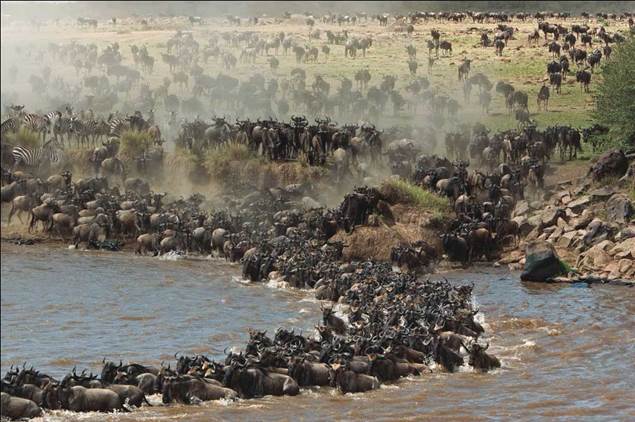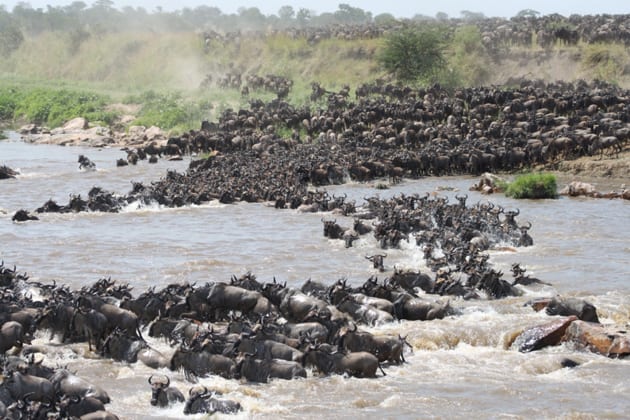The Great Wildebeest Migration is, without a doubt, one of the greatest wildlife spectacles in the world.
Travelers often call us, wanting to witness the migration, and ask “what time of year does the migration take place?” Well, the migration in fact is ALWAYS happening!
Over 1.7 million wildebeest and hundreds of thousands of zebra, eland and gazelle are constantly moving in a circle, seeking out the rains and resulting long, green grass in northern Tanzania and southern Kenya across the Serengeti and Maasai Mara ecosystems.
“The only beginning is the moment of birth,” said acclaimed East African author and photographer Jonathan Scott, who has spent the better part of the last 30 years chronicling the events of the Serengeti and Maasai Mara. Similarly the only ending of the Great Wildebeest migration is death.
If you would like to witness the Great Wildebeest Migration, here is where you can expect the animals to be throughout the year.
July – September: Around June the wildebeest migration is pressing towards the south side of the Grumeti River, in the western corridor of the Serengeti in Tanzania. The herds will build up to a high density before crossing the river and heading into Kenya.
Towards the end of June and early July, the herds push north crossing the border into Kenya. Here, following the green grass is dangerous business. The animals must cross several rivers to reach greener pastures. These rivers are full of crocodiles, who prey on the abundant wildebeest.

October: By October, the herds begin migrating back south into Tanzania, through western Loliondo and into the Serengeti National Park’s Lobo area.
November – December: Now, as the first of the short rains fall on the Serengeti’s short-grass plains, the wildebeest trek down through the eastern woodlands of the Serengeti. Many of the cows are heavily pregnant. During these months, expect to see wildebeest and zebra everywhere spread out on the Serengeti plains in Tanzania, feeding on the fresh grasses.
January – February: During these months, the wildebeest cows drop their young in a synchronized birthing that sees some 300,000 to 400,000 calves born within two to three weeks of one another, eight and a half months after the rut. The birthing occurs on the short-grass plains in Tanzania that, at the southernmost extent of the wildebeests’ range, spread over the lower northern slopes of the Ngorongoro Crater highlands and are scattered around Olduvai Gorge.
March: Towards the end of the short dry season, around March, the short-grass plains of the southernmost Serengeti begin to dry out and the wildebeest continue their journey, heading towards the western woodlands as they follow the rains and the growth of new grass.
April – June: As the rains set in, the herds head north-west past the granite outcrops of Moru koppies and into the hilly woodlands west of the Seronera area towards Lake Victoria in Tanzania. This is the time of the annual rut, with half a million cows mated in less than a month as the herds consolidate in the woodlands and on the plains of the Serengeti’s Western Corridor. The peak of the rut seems heavily influences by the state of the moon, with the full moon in May/June being a good bet for anyone seeking the most action.

So there you have it, where to be and when if you want to check out the Great Wildebeest migration. Here are a few of our favorite safari itineraries featuring the migration.
Tanzania Great Migration Safari
Exclusive Kenya – A Family Safari in Style
Please contact us today to start planning your custom adventure in Africa!
